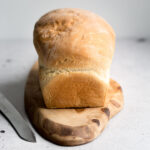Allowing dough to rise before baking is an essential step in achieving soft, fluffy bread that’s as good as you would get from the bakery. I’ve rounded up my best tips to help you ensure your dough rises EVERY time! Whether you’re making bread, pizza or something else, never have flat dough again!

In this post, I’m going to share my favourite tips and tricks to help you achieve the perfect rise every time you’re working with dough, from start to finish. However, there’s one KEY tip I have that trumps the rest… read on to learn more!
All my tips can be applied to bread dough and pizza dough alike, as they have the same base.
Different Types of Yeast
The raising agent used in dough is yeast, and it’s key to understand what it is and how it works to make sure that you get the best rise out of your dough. Yeast is a living microscopic organism that converts sugar or starch into carbon dioxide when used in baking. This is what will create a light, fluffy bread, as it creates hundreds of little air pockets within your dough.
There are two main types of bakers yeast: dry yeast and fresh yeast. Dry yeast is living but inactive, and can easily be found at the grocery store. It is sold in little sachets or packets and is in the form of very small, dry granules. Dry yeast can be stored for a long time, but still be sure to note the expiration date on the packet and always reseal securely if you open it.
The other type of yeast is fresh yeast. This yeast is sold in a block and needs to be crumbled to work with. It needs to be used within a week of purchase as it is active and living.
Either type of yeast will work fine, although I prefer the dried variety as I personally find it much more convenient!
So now for my first tip. The first step in making a dough is to dissolve the yeast in water, and as yeast is living, the temperature of the water is key to make sure that you don’t kill it off. The water does not need to be warm, but it shouldn’t be freezing cold – tepid room temperature water is ideal. You should then leave the yeast to completely dissolve and activate in the water for around 5 minutes before adding any other ingredients.
Kneading the Dough
Okay – so step one, done! Once you’ve added all your ingredients and formed them into a dough that holds together but isn’t sticky, you need to knead it thoroughly. As you probably guessed, this is the next key stage when making sure that your dough will rise perfectly.
When dough is kneaded, the gluten in the flour develops, which will turn your finished loaf from dense and tough to light and airy. You can either knead the dough by hand, or in a stand mixer with a dough hook attachment. Either way is fine, you just need to make sure that you’ve kneaded it thoroughly enough. In a machine on a medium speed, the dough should take around 7-8 minutes, and by hand it is nearer to 10-12 minutes.
What you are looking for is the point at which your dough becomes silky smooth and not sticky at all. Once it’s lost any appearance of lumpiness, it’s ready for it’s first rise.
My BEST tip for ensuring your dough rises
This is my favorite tip of them all. Too often have I made bread and done everything right, then I haven’t been able to find the perfect warm, non drafty place to provide the best environment for my dough to rise.
But there IS a place, no matter what the temperature outside, or how many drafts you have… your oven! It’s important that the oven isn’t switched on though, and that it is completely cold before you use it to help your dough rise.
Firstly, cover your dough in a little olive oil, and place it in a large bowl where the dough will have room to expand to at least twice its size, preferable more. Then cover the bowl completely with a piece of cling film which also has a little oil on it. The oil will prevent the dough sticking to any part of the bowl or film.
Next, place your bowl in the middle of your (completely cold and not switched on) oven. On the very bottom of the oven, place a small bowl and fill it with water that has just been boiled. Close the oven door and leave the dough for 60-90 minutes. The steam from the bowl on the bottom will create the perfect warm, moist environment that dough loves, and the oven will keep the whole area sealed and completely free of any drafts. Since using this technique, every single time I’ve made dough, it’s puffed up with no problems at all and my bread has turned out perfectly!


Second Rising
And now for the last stage in making sure your dough rises perfectly. When making bread, the instructions will normally call for a second rising, after you’ve beaten all the air out of the dough after the first rising. The reason for this is to create smaller air pockets and a finer crumb, and therefore more light, airy bread. Pizza dough normally only needs one rising though, as you bake it flat anyway.
If you’re doing a second rising, you can still use my oven technique to make sure you get a perfect rise!
So there you have it… my top tips to ensure your dough rises every time! First select your preferred yeast, allow it to develop in the water, knead the dough thoroughly and put it in an oven that is completely turned off, with a bowl of just boiled water.
Now you’re a pro at making dough, why not try these recipes which all use the same technique!
These Dough Balls with Homemade Garlic Butter are perfect for parties!

This beautifully soft Sweet Potato and Sun Dried Tomato Braided Bread is just so soft and perfect to serve as a starter!








